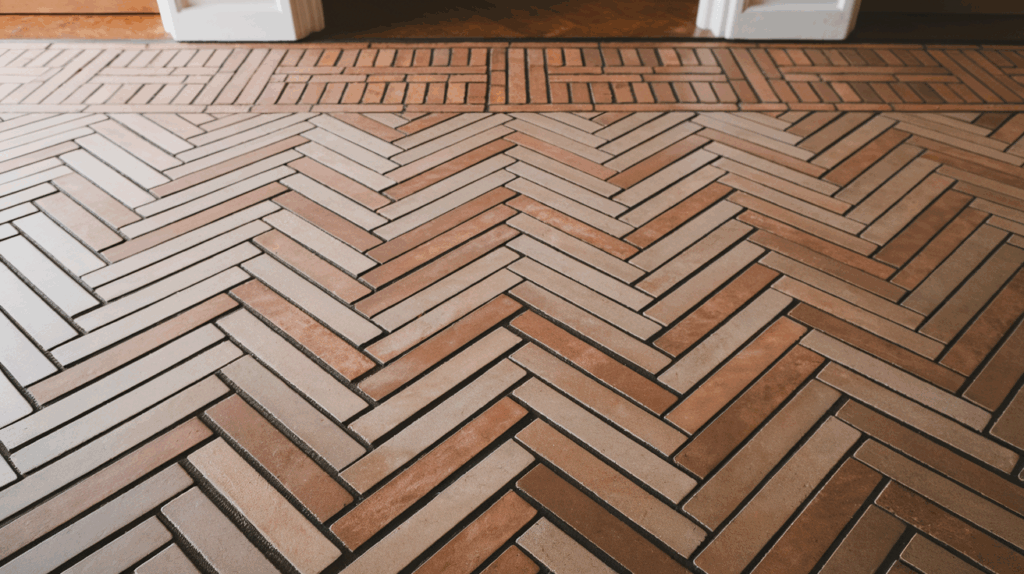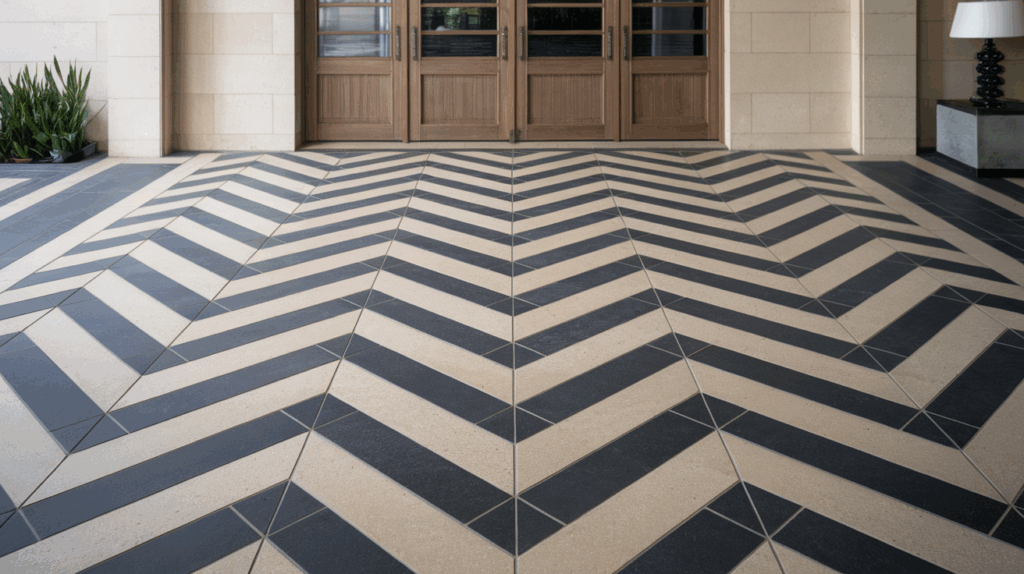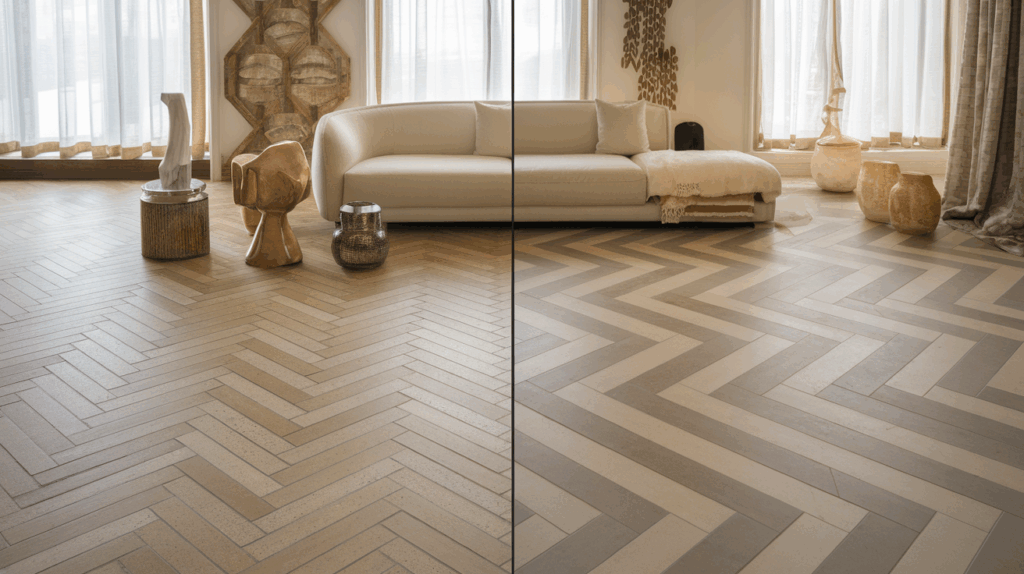When it comes to choosing between herringbone and chevron patterns for your floors, walls, or other spaces, it’s important to understand their distinct looks and how they can impact the overall design.
Both herringbone and chevron are visually striking patterns, but they have key differences that make them unique.
I’ll walk you through these differences, so you can decide which one works best for your home.
By the end of this blog, you’ll have a clearer understanding of the features, aesthetics, and appropriate uses of each pattern.
This will help you make an informed decision about which pattern fits your style and space.
Herringbone Pattern: A Timeless Classic

The herringbone pattern is one of the oldest and most popular choices in design, especially for flooring.
It consists of rectangular tiles arranged in a zigzag pattern, but unlike the chevron pattern, the tiles are not joined at an angle.
Instead, they are laid in a way that forms a broken zigzag, which gives the design its signature “V” shape with a staggered effect.
This creates a unique visual texture that is both dynamic and timeless.
It’s a classic look that’s suitable for both traditional and modern spaces, adding depth to a room without overwhelming it.
Chevron Pattern: A Sharp, Clean Design

On the other hand, the chevron pattern is much more defined and bold.
It also uses rectangular tiles arranged in a zigzag pattern, but the tiles are cut at a 45-degree angle, creating a continuous, clean “V” shape that flows seamlessly.
The lines in a chevron design are sharper, resulting in a more polished and streamlined look compared to the herringbone pattern.
This design tends to be more striking and is often used in spaces where a bold statement is desired.
Key Differences Between Herringbone and Chevron

Herringbone and chevron patterns may seem similar at first glance, but they have distinct differences in design and how they’re laid out.
1. Tile Angles and Layout
The most noticeable difference is in how the tiles are laid.
In herringbone, the tiles are not cut at angles but are arranged in a straight line, forming a staggered “V” pattern.
In contrast, chevron tiles are cut at an angle, creating a sharp, continuous V-shape without the staggered effect. This means chevron creates a smoother, more cohesive look, while herringbone has more of a broken, traditional vibe.
2. Visual Impact
Herringbone patterns tend to be more subtle and add texture without drawing too much attention. This is ideal for creating a sophisticated background in a room.
Chevron, on the other hand, is much bolder and can act as the focal point of a space. The sharp angles create a sense of movement and energy, making it perfect for dramatic, high-impact areas.
3. Installation Complexity
Installation of herringbone flooring can be slightly more challenging because the tiles need to be cut and placed in a staggered, broken zigzag pattern.
Chevron is more straightforward since the tiles are angled and placed in a continuous, uniform way.
Both patterns require precision, but chevron can often be a bit quicker to install because it doesn’t involve the same amount of tile manipulation.
4. Style and Aesthetics
Herringbone has a more classic and elegant feel, often associated with traditional European styles. It works well in both contemporary and vintage interiors, giving a room a warm, textured appearance.
Chevron, however, gives a more modern and dynamic look. It can be a great way to add a contemporary touch to a room or to highlight a feature area, like a statement wall.
5. Versatility
While both patterns are versatile, herringbone tends to blend in more easily with various types of decor. It works well in high-traffic areas, like hallways or living rooms, and can be used in both traditional and modern interiors.
Chevron, however, is a more striking pattern that is best used in areas where you want to make a bold statement. It pairs well with modern, minimalist styles and works well as a focal point.
6. Materials
Both patterns can be created with various materials, including wood, tile, and even marble.
Herringbone is often found in hardwood flooring, but it can also work well in tile or stone.
Chevron is often seen in more luxurious materials like polished marble or high-quality wood, as the sharp angles emphasize the material’s beauty and craftsmanship.
Pros and Cons of Herringbone vs Chevron Designs
Understanding the advantages and drawbacks of both herringbone and chevron patterns can help you decide which one fits your project.
Herringbone Pattern
| Pros | Cons |
|---|---|
| Timeless, classic appeal | Requires more precise installation, making it labor-intensive |
| Adds a sophisticated, elegant look to any room | Can feel busy or overwhelmed in small rooms |
| Creates a sense of space and depth, especially in narrow areas | It may be harder to match with certain décor styles |
| Works well in both traditional and modern settings |
Chevron Pattern
| Pros | Cons |
|---|---|
| Bold and dynamic appearance that adds movement to a space | Can feel overwhelming or too bold in smaller spaces |
| Creates a visually striking design that works well as a focal point | Installation can still be intricate, but slightly easier than herringbone |
| Offers a more modern, sharp look compared to other patterns | May not complement certain interior styles due to its strong geometric form |
Cost Comparison: Herringbone vs Chevron Tile Patterns
Cost plays a crucial role when deciding on your tile pattern, especially when factoring in both materials and installation.
Herringbone Pattern:
- Higher tile cost due to intricate cuts and layout.
- Requires precise cuts and alignment, making installation more difficult.
- Labor costs are higher due to the complexity of installation, leading to a more expensive overall cost.
Chevron Pattern:
- Slightly more affordable tiles compared to herringbone.
- Requires alignment but less cutting, making installation easier.
- Lower labor costs compared to herringbone, making it more affordable overall.
Factor in both tile and labor costs when deciding which pattern fits your budget. Herringbone offers a luxurious look but can be more expensive, while chevron offers a similar effect at a lower cost.
Which One Should You Choose?
Both herringbone and chevron are stunning options, but the decision ultimately comes down to the type of look and feel you want for your space.
If you want something that feels traditional yet modern, herringbone is your go-to option.
It provides a timeless look that works with a variety of styles and is ideal for areas where you want subtle elegance.
Chevron, on the other hand, is perfect for making a bold statement.
If you’re looking for a floor or wall pattern that exudes energy and sharp design, chevron is the way to go.
Conclusion
When choosing between herringbone and chevron, I recommend thinking about the mood you want to create in your space.
Herringbone offers a classic, understated charm, while chevron makes a bold, dramatic statement.
Both patterns can bring beauty and personality to your home, but their unique qualities set them apart.
Understanding their differences will help you make a more informed decision about which pattern works best with your overall design goals.
Remember, both styles are timeless, and either will undoubtedly add lasting value to your home.

